7.8 /10 1 Votes
7.9/10 TV No. of seasons 4 Theme song Route 66 Theme Song | 7.7/10 IMDb Country of origin United States First episode date 7 October 1960 | |||||||||||||||||||||||||||||||||
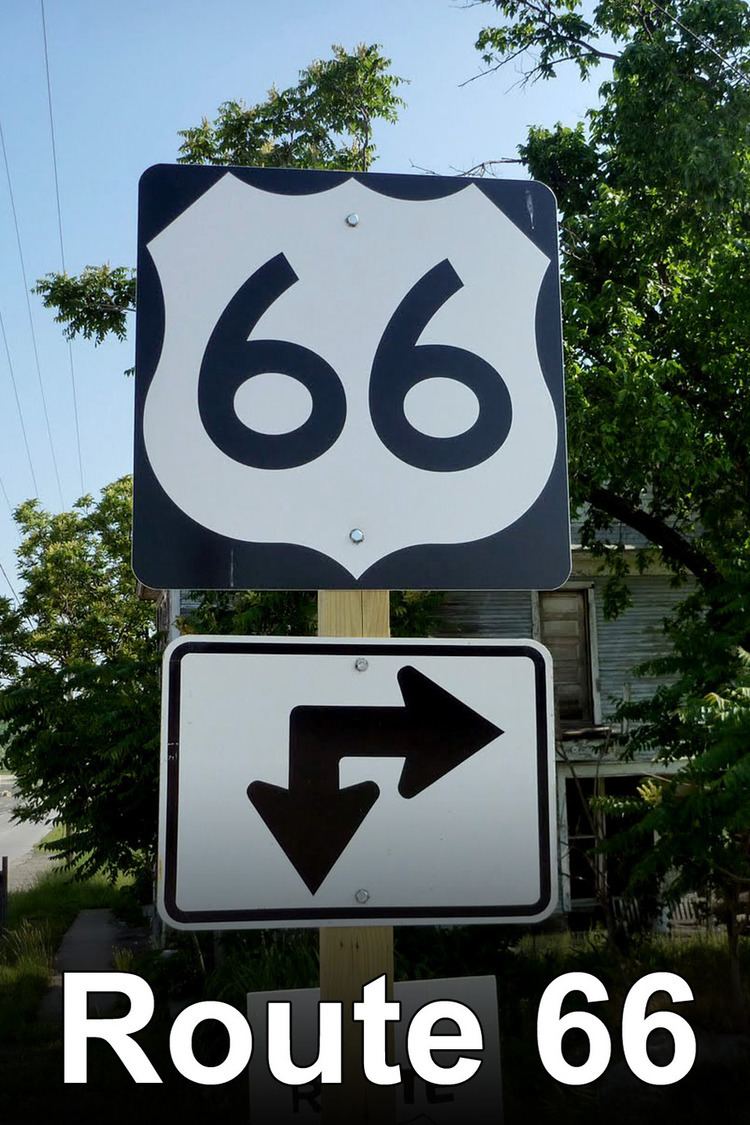 | ||||||||||||||||||||||||||||||||||
Created by Herbert B. LeonardStirling Silliphant Cast | ||||||||||||||||||||||||||||||||||
Route 66 somehow it gets to be tomorrow
Route 66 is an American television drama that premiered on CBS on October 7, 1960, and ran until March 20, 1964, for a total of 116 episodes. The series was created by Herbert B. Leonard and Stirling Silliphant, who were also responsible for the ABC drama Naked City, from which Route 66 was indirectly spun off. Both series employed a format with elements of both traditional drama and anthology drama, but the difference was where the shows were set: Naked City was set in New York City, while Route 66 had its setting change from week to week, with each episode being shot on location in the area in which it was set.
Contents
- Route 66 somehow it gets to be tomorrow
- Route 66 the swan bed
- Format and characters
- Original concept and trial pilot
- Character profiles
- Locations
- Guest stars
- Scripts
- Theme song
- Car
- Awards and nominations
- Broadcast history
- Fourth season 19631964
- DVD releases
- Cultural impact
- Sequel
- References
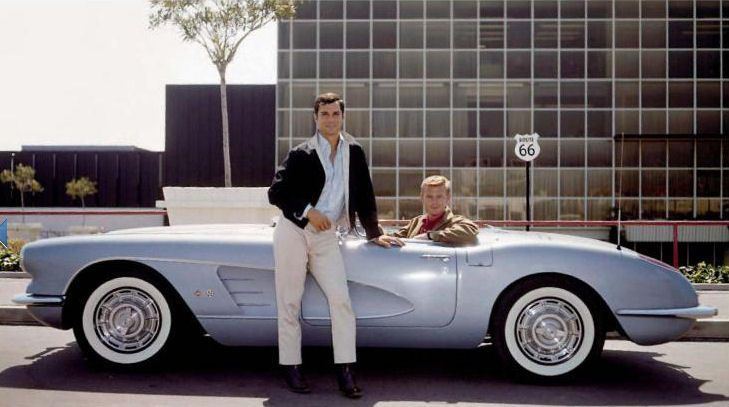
Route 66 followed two young men traversing the United States in a Chevrolet Corvette convertible, and the events and consequences surrounding their journeys. Martin Milner starred as Tod Stiles, a recent college graduate with no future prospects due to circumstances beyond his control. He was originally joined on his travels by Buz Murdock, a friend and former employee of his father (played by George Maharis), with the character leaving midway through the third season after contracting echovirus. Near the end of the third season, Tod met a recently discharged Vietnam veteran named Lincoln Case, played by Glenn Corbett, who decided to follow Tod on his travels and stayed with him until the final episode.
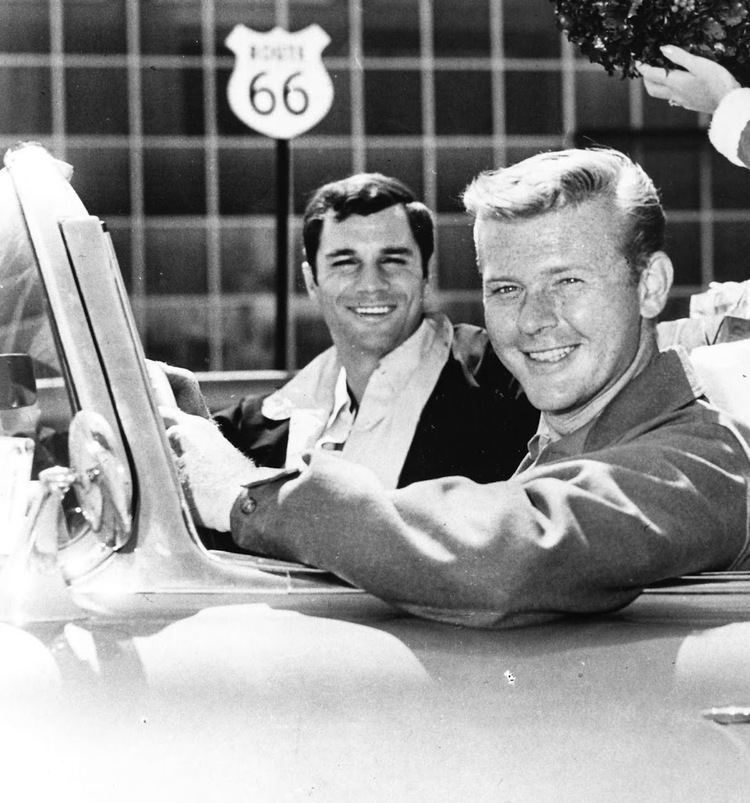
Route 66 the swan bed
Format and characters
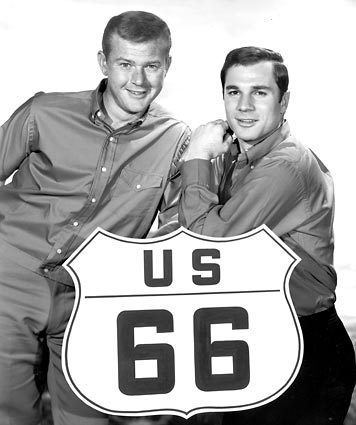
Route 66 was a hybrid between episodic television drama, which has continuing characters and situations, and the anthology format (e.g., The Twilight Zone), in which each week's show has a completely different cast and story. It was inspired by On the Road, written by Jack Kerouac. In this narrative format, dubbed "semi-anthology" by the trade paper Variety, the drama usually centers on the guest stars rather than the regular cast. Series creator Stirling Silliphant's concurrently running drama, Naked City (1958–1963), also followed this semianthology format. Both shows were recognized for their literate scripts and rich characterizations. The open-ended format, featuring two roaming observers/facilitators, gave Silliphant and the other writers an almost unlimited landscape for presenting a wide variety of dramatic (or comedic) story lines. Virtually any tale could be adapted to the series. The two regulars merely had to be worked in and the setting tailored to fit the location. Like Richard Kimble from The Fugitive, the wanderers moved from place to place and got caught up in the struggles of the people there. Unlike Kimble, nothing was forcing them to stay on the move except their own sense of adventure, thus making it thematically closer to Run for Your Life, Maverick, Movin' On, and Then Came Bronson.
Original concept and trial pilot
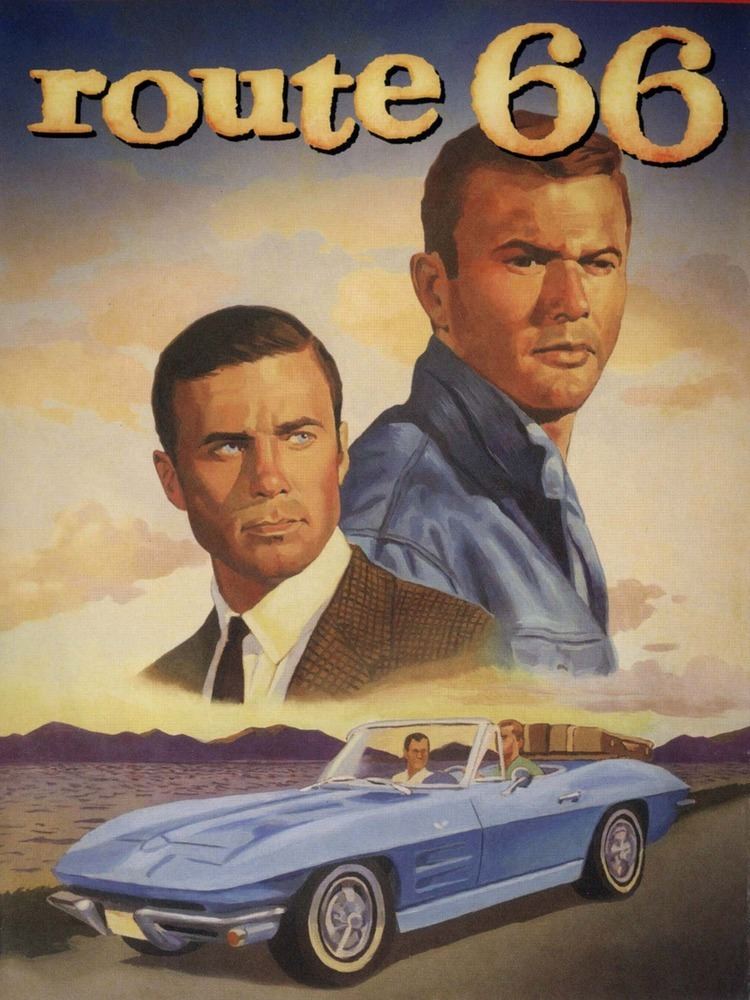
In the original concept under discussion between Silliphant and producer Herbert Leonard, the two series leads were both to be ex-army men who had left the service, and were looking to re-establish themselves in American life. George Maharis was signed to a contract by Leonard before the Route 66 concept had even been fully developed, and was set to be a cast member from the very beginning. An actor named Bob Morris was set to be the other lead.
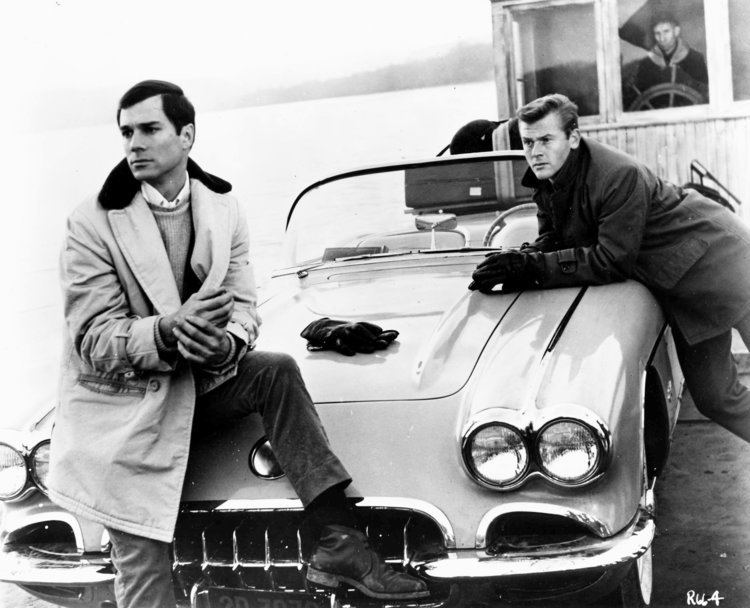
Morris was cast beside Maharis in a 1959 episode of Naked City that was written by Silliphant as a backdoor pilot to a potential spin-off series featuring two young travellers who were looking to find themselves. At that point, the Route 66 title was not yet decided upon, and the potential spin-off was tentatively entitled The Searchers. The Naked City episode that served as the Searchers pilot was called "Four Sweet Corners", and in it, Maharis played Johnny Gary, while Morris was Link Ridgeway. Both were ex-servicemen. After spending most of the episode rescuing Johnny's kid sister from a shoplifting ring, the two friends decided they were too restless to stay in New York City, and more of the world existed that they had to see. Johnny and Link ended the episode by leaving Johnny's family's apartment building, setting out for parts unknown.
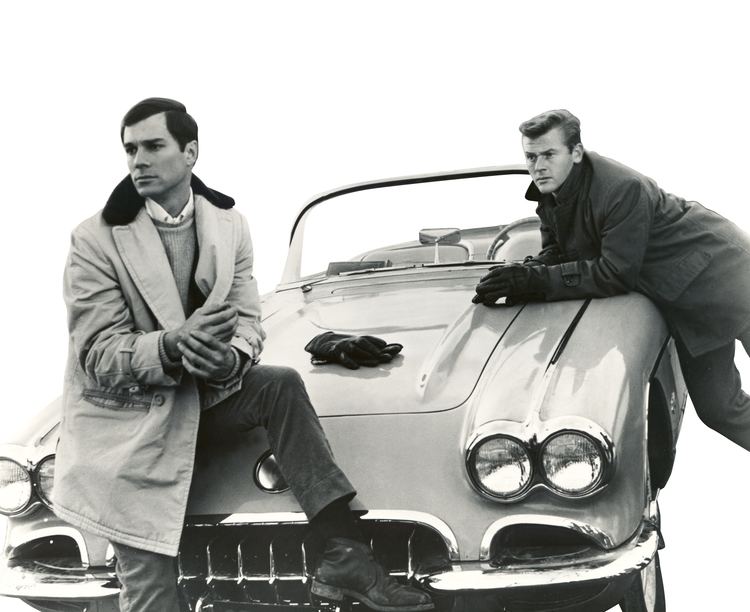
The half-hour pilot and the chemistry between the leads was judged to be good by the producers, although Herbert B. Leonard could not interest a network or a sponsor in the spin-off show. Morris died in 1960 of a cerebral hemorrhage.
The concept was subsequently reworked. The title of the series became Route 66, the leads became Tod and Buz, and neither had ties to the army. Maharis was given the role of Buz, while Martin Milner beat out several actors (including Robert Redford) for the role of Tod. Leonard personally financed the shooting of a new hour-long pilot episode ("Black November", written by Silliphant) and CBS picked up the series in 1960.
Character profiles
Tod and Buz (and later, Linc) symbolized restless youth searching for meaning in the early 1960s. The two men take odd jobs along their journey, like toiling in a California vineyard or manning a Maine lobster boat, bringing them in contact with dysfunctional families or troubled individuals in need of help. The lead characters are not always the focus of any given episode, and their backstories are revealed only in occasional references across widely spaced episodes.
Tod Stiles, portrayed by clean-cut Milner, is the epitome of the decent, honest, all-American type. Tod came from a background of wealth and privilege; his father owned a shipping company, and Tod's early years were spent in New York and Connecticut. He attended Yale, but after the death of his father, Tod discovered that his father's business had essentially gone bankrupt. The only legacy left to Tod was a new Corvette.
Buz Murdock, meanwhile, was an orphan who had worked with Tod's father as a laborer on one of his ships in New York City. After the death of the senior Mr. Stiles, and the subsequent collapse of his business, Tod and Buz decided to drive across America in search of work, adventure, and themselves. The working-class Buz (George Maharis) is looser, hipper, and more Beat Generation in attitude than Tod, though the two characters share a mutual respect for each other. Subtle indications were given that the Buz character was intended to loosely embody Jack Kerouac in appearance and attitude. Kerouac, in fact, contemplated a lawsuit against Leonard, Silliphant, and Chevrolet for misappropriating the characters and theme from his iconic novel On the Road.
Towards the end of the second season, Maharis was absent for several episodes, due to a bout of infectious hepatitis. He returned for the start of the third season, but was again absent for a number of episodes before leaving the show entirely midway through season three. Consequently, in numerous episodes in late season two and early season three, Tod travels solo, while Buz is said to be in the hospital with "echovirus". Tod is often seen writing to Buz in these episodes, or having a one-sided phone conversation with him. In total, Tod appears solo in 13 episodes during seasons two and three.
Buz made his final appearance in a January 1963 episode, and was then written out of the show without a definitive explanation. Then, after five consecutive solo Tod stories, Tod gained a new traveling companion named Lincoln Case (Glenn Corbett) in March 1963. Case is a darker character than Buz Murdock, an army veteran haunted by his past. Tod met Linc in "Fifty Miles From Home", where Linc got into a fight with an aspiring basketball player outside a Houston bus station. Linc severely injured the young man, whom Tod was coaching and training, and the incensed Tod followed Linc to his hometown, where he challenged him to a fistfight. After some prolonged, bloody, sweaty, pugilistic choreography, the two came to an understanding of where Linc had been in life. There, Linc became Tod's new traveling companion. Linc was more introspective than the happy-go-lucky Buz, with a sometimes explosive temper, but he is nonetheless a reliable companion as the duo continues their travels. Due to the similarity of names and backgrounds, Linc is more than a little reminiscent of Link Ridgeway from the Naked City episode "Four Sweet Corners" that had served as Route 66's back door pilot.
The series concluded in Tampa, Florida, with the two-part episode "Where There's a Will, There's a Way," in which Tod Stiles got married, and Linc announced his intention to return home to his family in Texas, after a long period of estrangement. Tod was headed with his new wife back to Houston and offered to bring Linc, who had to remind Tod how small the car was. The scene ends with Linc walking up a hill after loading the couple's luggage on the Corvette. This episode made the series one of the earlier primetime television dramas to have a planned series finale resolving the fate of its main characters.
The show was filmed and presented in black and white throughout its run.
Locations
Route 66 is well remembered for its cinematography and location filming. Writer-producer Stirling Silliphant traveled the country with a location manager (Sam Manners), scouting a wide range of locales and writing scripts to match the settings. The actors and film crew would arrive a few months later. Memorable locations include a logging camp, shrimp boats, an offshore oil rig, and Glen Canyon Dam, the latter while still under construction.
The show had little connection with the U.S. Highway providing its name. Most of the locations in the series were far from "The Mother Road", which passed through only eight states, while the series was filmed in 25 American states plus (one episode) Toronto, Ontario, Canada (another episode featured a brief coda set in Mexico, but was filmed in California). U.S. Route 66 the highway was briefly referred to in just three early episodes of the series ("Black November", "Play It Glissando", and "An Absence of Tears"). The actual highway is even more rarely shown, as in the early first-season episode, "The Strengthening Angels".
Route 66 is one of few series in the history of television to be filmed entirely on the road. This was done at a time when the United States was much less homogeneous than it is now. People, their accents, livelihoods, ethnic backgrounds, and attitudes varied widely from one location to the next. Scripted characters reflected a far less mobile, provincial society, in which people were more apt to spend their entire lives in one part of the country. Similarly, the places were very different from one another visually, environmentally, architecturally, in goods and services available, etc. Stars Martin Milner and George Maharis mentioned this in 1980s interviews. "Now you can go wherever you want," Maharis added by way of contrast, "and it's a Denny's."
Guest stars
The roster of guest stars on Route 66 includes several actors who later went on to fame, as well as major stars on the downward side of their careers. One of the most historically significant episodes of the series in this respect was "Lizard's Leg and Owlet's Wing". It featured Lon Chaney, Jr., Peter Lorre, and Boris Karloff as themselves, with the latter donning his famous Frankenstein monster make-up for the first time in 25 years and Chaney reprising his role as the Wolfman. The show was filmed at the O'Hare Inn, near O'Hare Airport, Chicago. Dutch singer Ronnie Tober had a small guest role with Sharon Russo, Junior Miss America.
Other notable guest stars were Elizabeth Ashley, Ed Asner, Lew Ayres, Diane Baker, Martin Balsam, Richard Basehart, Ed Begley, Theodore Bikel, Beulah Bondi, James Brown (of Leonard's previous show, Rin Tin Tin multiple times and the actual Rin Tin Tin dog once with a guest-starring credit as a guide dog in "Absence of Tears"), Joe E. Brown, Edgar Buchanan, James Caan, James Coburn, Joan Crawford, James Dunn, Robert Duvall, Barbara Eden, Betty Field, Nina Foch, Anne Francis, Tammy Grimes, Signe Hasso, Sessue Hayakawa, Joey Heatherton, Steven Hill, Miriam Hopkins, Vivi Janiss, David Janssen, Ben Johnson, Buster Keaton, Cloris Leachman, Robert Loggia, Jack Lord, Tina Louise, Dorothy Malone, E.G. Marshall, Lee Marvin, Walter Matthau, Kent McCord (who would later costar with Martin Milner in the TV series Adam-12), Patty McCormack, Darren McGavin, Ralph Meeker, Dolores Michaels, Vera Miles, Roger Mobley, Chester Morris, Lois Nettleton, Leslie Nielsen, Arthur O'Connell, Susan Oliver, Nehemiah Persoff, Lee Philips, Suzanne Pleshette, Stefanie Powers, Robert Redford, Michael Rennie, Alejandro Rey, Madlyn Rhue, Jeannine Riley, Ruth Roman, Jane Rose, Marion Ross, Janice Rule, Soupy Sales, Martha Scott, Martin Sheen, Sylvia Sidney, Lois Smith, Rod Steiger, Beatrice Straight, Barry Sullivan, Joan Tompkins, Rip Torn, Jo Van Fleet, Alex Viespi, Jessica Walter, Jack Warden, Tuesday Weld, Jack Weston, James Whitmore, and Dick York. Several appeared in more than one episode, sometimes as different characters. Julie Newmar is especially memorable as a motorcycle-riding free-spirit—a role she reprised in a later episode. William Shatner and DeForest Kelley (both of whom would later go on to fame by starring in the TV series Star Trek and appearing in seven Star Trek films) also guest-starred, in separate episodes. Two others were Logan Ramsey and Bruce Glover; both later appeared in the three theatrical movies about Buford Pusser, Walking Tall, Walking Tall Part 2, and Walking Tall: Final Chapter. Ed Asner and Lois Nettleton, who appeared in the episode, "The Opponent", appeared in the 2006 Christmas movie, The Christmas Card. Keir Dullea, Gene Hackman, Ron Howard, George Kennedy, and Burt Reynolds, among other future stars, appeared in small bit parts.
In a 1986 interview, Martin Milner reported that Lee Marvin credited him with helping his career by breaking Marvin's nose "just enough" to improve his look. This happened in Pittsburgh, Pennsylvania, during a scripted fistfight for "Mon Petit Chou", the second of two episodes with Marvin.
Two late third-season episodes, which aired one week apart, each featured a guest star in a bit part playing a character with a profession with which he would later become associated as the star of his own mega-hit television series. In "Shadows of an Afternoon", Michael Conrad was a uniformed policeman, years before he became famous as Police Sgt. Phil Esterhaus on Hill Street Blues. In "Soda Pop and Paper Flags", Alan Alda guest-starred as a surgeon, a precursor to his career-defining role as Dr. Benjamin Franklin "Hawkeye" Pierce on M*A*S*M*A*S*H. Also in the first-season episode, "The Strengthening Angels", which aired November 4, 1960, Hal Smith, who played town drunk Otis Campbell in The Andy Griffith Show, also played a drunk named Howard and was listed in the credits as "Drunk".
A fourth-season episode, "Is It True There Are Poxies at the Bottom of Landfair Lake?", featured guest stars Geoffrey Horne and Collin Wilcox. In the episode's story line, Wilcox's character pretended to get married to Horne's, although it turned out to be a practical joke. A few years after appearing in this episode, Horne and Wilcox were briefly married to each other in real life.
A noteworthy in-joke occurs during the fourth-season episode, "Where Are the Sounds of Celli Brahams?" In this segment, Horace McMahon guest stars as a Minneapolis, Minnesota, festival promoter. His character confesses to Linc his failed ambition to be a policeman. Linc remarks that he looks like a policeman Linc once knew in New York City. McMahon had starred as Lt. Mike Parker on the New York-based police drama Naked City from 1958 to '63, another TV series overseen by the creative team of Silliphant and Leonard.
Scripts
Route 66 was officially created by producer Herbert B. Leonard and writer Stirling Silliphant; Silliphant wrote the majority of the episodes (including the pilot) while Leonard did not write at all. It was notable for its dark story lines and exceptional realism. Tod and Buz frequently became involved with individuals whose almost nihilistic world view made for occasionally frightening TV. Some 50 years after its premiere, Route 66 is still one of the few TV series to offer such a range of socially conscious stories, including mercy killing, the threat of nuclear annihilation, terrorism, runaways, and orphans. Other episodes dealt with the mentally ill, lupus, drug addiction, or gang violence. Some stories were lighthearted, such as a memorable episode featuring Richard Basehart as a folklorist trying to record the music of an isolated Appalachian community, and a Halloween episode called "Lizard's Leg and Owlet's Wing".
Even more unusual is the way it served up a kind of soaring dialog that has been referred to as "Shakespearean" and free-verse poetry. For instance, the boys encounter a Nazi hunter named Bartlett on the offshore oil drilling rig where they work. Bartlett describes the horrors of World War II and the Holocaust thus: "Tod, I hope you live a long life and never know the blistering forces that sear and destroy, turn men into enemies and sweep past the last frontiers of compassion" and "Once you've seen that dark, unceasing tide of faces...of the victims...the last spark of dignity so obliterated that not one face is lifted to heaven, not one voice is raised in protest even as they died..." (from episode four, "The Man on the Monkey Board").
The quirky, textured writing extended to episode titles, which included such oddities as "How Much a Pound is Albatross?" and "Ever Ride the Waves in Oklahoma?", the latter causing a sensation as a 'surfing story' where Buz oddly berates a surf bum for existing without purpose. Other episode titles were drawn from a wide range of literary sources, such as Shakespeare ("A Lance of Straw", "Hell is Empty, All the Devils are Here") or Alfred, Lord Tennyson ("A Fury Slinging Flame").
Many of the stories were character studies, like the above-mentioned one featuring Richard Basehart as a man who uses people then tosses them away. The episode titled "You Can't Pick Cotton in Tahiti" refers to small-town America as both a far-away, exotic Tahiti and the "real America" compared to "phony-baloney" Hollywood. Many episodes offer moving soliloquies, into which future Academy Award-winning writer Silliphant (In the Heat of the Night) poured his deepest thoughts.
Despite all the adventure, travelogue, drama, and poetry, the real subject of the series was the human condition, with Tod and Buz often cast as a kind of roving Greek chorus, observers and mentors to broken-down prizefighters and rodeo clowns, sadists and iron-willed matrons, surfers and heiresses, runaway kids and orphans, and other people from all walks of life, forced by circumstances to confront their demons.
One hallmark of the show was the way it introduced viewers to new ways of life and new cultures, for instance, a view of a shrimper's life in episode two of season one, "A Lance of Straw", and a look at Cleveland, Ohio's Polish community in episode 35, "First Class Mouliak". Here, the young are pushed by their parents into careers and marriages they may not want, in an effort to hold community and family together, albeit at the expense of the happiness and well-being of the children. This story featured Robert Redford, Martin Balsam, Nehemiah Persoff, and Nancy Malone as guest stars.
One of the legacies Route 66 left behind is a dramatic and photographic portrait of early 1960s America as a less crowded and less complicated era — if not a less violent one — in which altruism and optimism still had a place. That place was filled by two young men who seemed to represent the best in us, the willingness to stand up for the weak, old-fashioned values like honesty, and the physical courage necessary to fight in their own and others' defense. In their role of wanderers, they appeared to be peaceful rebels who rejected, at least for a time, material possessions and the American dream of owning a home. The boys were de facto orphans adrift in American society; as such, they embodied facets of Jack Kerouac's Beat Generation, a little bit of Marlon Brando's wild side from The Wild One, James Dean's inability to settle down and fit in from Rebel Without a Cause, and the wanderlust of the above-mentioned Jim Bronson, the traveling writer and loner who toured the USA on a motorcycle in the 1969–1970 series Then Came Bronson. While often cited as a reference point, Kerouac was not necessarily a supportive fellow traveler of the series, having contemplated filing a lawsuit against the producers and Chevrolet for infringement and misappropriation of his themes and characters from his iconic On The Road novel. The use of the Corvette on Route 66, not only as the boys' transportation, but also as their marquee and symbol of their wandering spirit, created a link between America's Sports Car and America's highways that endures to this day.
Theme song
Nelson Riddle was commissioned to write the instrumental theme when CBS decided to have a new song, rather than pay royalties for the Bobby Troup song "(Get Your Kicks on) Route 66." Riddle's theme, however, offers an unmistakable homage to the latter's piano solo (as originally recorded by Nat King Cole) throughout the number. Riddle's "Route 66 Theme" instrumental was one of the first television themes to make Billboard magazine's top 30, following Ray Anthony's "Dragnet Theme" (in 1953), Anthony's version of Henry Mancini's "Peter Gunn Theme" (in 1959) and Mancini's "Mr. Lucky Theme" (in 1960). The song earned two Grammy nominations in 1962. A vocal version, retitled "Open Highway" and featuring lyrics by Stanley Styne, was recorded by jazz singer Teri Thornton and reached number 150 in the Music Vendor survey of October 1963.
Car
George Maharis reported in a 1986 Nick at Nite interview that people often ask about "the red Corvette." According to Maharis, the Corvette was never red. (The misconception may stem from the box illustration on the official board game, released by Transogram in 1962, which showed Tod and Buz in a red-colored model.) It was light blue the first season (in which a 1960 Corvette appeared in the pilot episode, and a 1961 Corvette was used in all subsequent first-season episodes), and Fawn Beige for the second season (on a 1962) — although in the episode "To Walk with the Serpent" it is described as green — and Saddle Tan (on 1963 and 1964 Corvette Sting Rays) for the third and fourth seasons. Those colors were chosen to photograph well in black and white, but the show's cinematographer complained that the powder blue car reflected too much light. The Corvette was replaced with a newer model annually by series' sponsor Chevrolet, but the show never mentioned or explained the technicality, though the series' travels apparently took them through St. Louis, (where Corvettes were then assembled). The model update made a particular splash in the third season, when the new Corvette Sting Ray introduced the then-revolutionary design change of headlights that rotated into the hoodline when not in use. Virtually every car and truck driven by each episode's characters, and used in street scenes, were different variations of Chevrolets. Chevrolet also supplied the trucks that transported the show's company, and a Chevrolet Corvair Greenbrier van for Milner and his family. Yet, George Maharis claimed in a radio interview, Chevrolet never allowed Milner nor Maharis to use the Corvette other than in film shooting. Maharis thought it may have been for insurance reasons.
Awards and nominations
Broadcast history
Route 66 aired Friday at 8:30–9:30 pm on CBS its entire run.
Fourth season (1963–1964)
§: "A Cage in Search of a Bird" and "I'm Here to Kill a King" were originally scheduled to air on November 22 and 29, 1963, respectively. CBS' coverage of the assassination of John F. Kennedy necessitated the programming changes. "A Cage In Search Of A Bird" was simply moved back one week, but as "I'm Here To Kill A King" dealt with the topic of political assassination, it was unsuitable for broadcast in the immediate wake of Kennedy's death. Some sources indicate that "I'm Here To Kill A King" aired on CBS on March 20, 1964, one week after the series finale. However, contemporary television listings in The New York Times and other U.S. newspapers list the episode of March 20 as a rerun of season three's "Hey, Moth, Come Eat the Flame". "I'm Here To Kill A King" was made available in syndication when Route 66 was syndicated starting in the 1964/65 season.
DVD releases
Roxbury Entertainment released the first three seasons of Route 66 on DVD in Region 1 between 2008–2010. As of November 2011, these releases are now out of print as Roxbury Entertainment no longer possesses the rights to the series.
On November 7, 2011, Shout! Factory announced that it had acquired the exclusive rights to the series, including the home entertainment rights. It planned on releasing the series through multiple platforms, including DVD releases. It subsequently announced that it would release Route 66—The Complete Series on DVD in Region 1 on May 22, 2012. The 24-disc collectors box set would feature all 116 episodes of the series as well as special bonus features.
Cultural impact
Sequel
A revival/sequel to the original Route 66 aired on NBC in 1993. Premiering on June 8 of that year, the premise of the series was that a son of Buz, Nick Lewis (James Wilder), had inherited a Corvette from his father (apparently ignoring the events following George Maharis' departure from the original series). Using it to travel the country, he picked up a hitchhiker named Arthur Clark (Dan Cortese) and he became his traveling partner -- making the travelers "Lewis and Clark". NBC aired only four episodes before cancelling the revival due to low ratings. A pilot featuring different casting was also produced.
